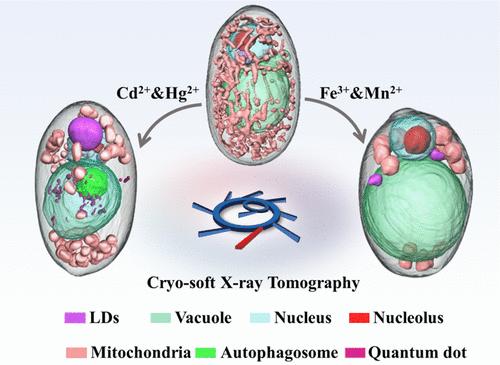金属离子引发的细胞状态转变的近原态成像
IF 16
1区 材料科学
Q1 CHEMISTRY, MULTIDISCIPLINARY
引用次数: 0
摘要
金属离子对生命是不可或缺的,因为它们可以作为基本的酶辅因子来驱动基本的生化反应,但矛盾的是,过量的金属离子是剧毒的。高阶细胞已经进化出功能独特的细胞器,它们分离和协调复杂的生化过程,以维持细胞在金属离子刺激下的稳态。在这里,我们揭示了几种金属离子刺激引发的酵母亚细胞结构和细胞器相互作用的重塑,依赖于近天然三维成像,低温软x射线断层扫描。完整酵母的三维结构直接表明,铁或锰会引发一种类似激效的效应,促进细胞增殖。这一过程导致细胞器在准备分裂时进行重组,其特征是线粒体极性分布,脂滴(ld)数量增加,体积缩小,形成空心结构。此外,可以观察到从液泡中分离出来的囊泡样结构。相反,镉或汞会导致与应激相关的表型,包括线粒体断裂、LD肿胀和自噬体形成。值得注意的是,细胞器相互作用组,包括线粒体与ld之间的相互作用以及核膜与ld之间的相互作用,是量化的,并且在不同金属离子的作用下表现出多方面的变化特征。更重要的是,与评估细胞状态的传统方法相比,细胞器结构的动力学使它们成为更敏感的生物标志物。引人注目的是,酵母具有强大的净化能力,可以将液泡、线粒体和细胞质中过度积累的镉分离并转化为高价值产品量子点。这项工作提出了发现细胞器形态特征和细胞状态之间的基本联系的可能性。本文章由计算机程序翻译,如有差异,请以英文原文为准。

Near-Native Imaging of Metal Ion-Initiated Cell State Transition
Metal ions are indispensable to life, as they can serve as essential enzyme cofactors to drive fundamental biochemical reactions, yet paradoxically, excess is highly toxic. Higher-order cells have evolved functionally distinct organelles that separate and coordinate sophisticated biochemical processes to maintain cellular homeostasis upon metal ion stimuli. Here, we uncover the remodeling of subcellular architecture and organellar interactome in yeast initiated by several metal ion stimulations, relying on near-native three-dimensional imaging, cryo-soft X-ray tomography. The three-dimensional architecture of intact yeast directly shows that iron or manganese triggers a hormesis-like effect that promotes cell proliferation. This process leads to the reorganization of organelles in the preparation for division, characterized by the polar distribution of mitochondria, an increased number of lipid droplets (LDs), volume shrinkage, and the formation of a hollow structure. Additionally, vesicle-like structures that detach from the vacuole are observed. Oppositely, cadmium or mercury causes stress-associated phenotypes, including mitochondrial fragmentation, LD swelling, and autophagosome formation. Notably, the organellar interactome, encompassing the interactions between mitochondria and LDs and those between the nuclear envelope and LDs, is quantified and exhibits alteration with multifaceted features in response to different metal ions. More importantly, the dynamics of organellar architecture render them more sensitive biomarkers than traditional approaches for assessing the cell state. Strikingly, yeast has a powerful depuration capacity to isolate and transform the overaccumulated cadmium in the vacuole, mitochondria, and cytoplasm as a high-value product, quantum dots. This work presents the possibility of discovering fundamental links between organellar morphological characteristics and the cell state.
求助全文
通过发布文献求助,成功后即可免费获取论文全文。
去求助
来源期刊

ACS Nano
工程技术-材料科学:综合
CiteScore
26.00
自引率
4.10%
发文量
1627
审稿时长
1.7 months
期刊介绍:
ACS Nano, published monthly, serves as an international forum for comprehensive articles on nanoscience and nanotechnology research at the intersections of chemistry, biology, materials science, physics, and engineering. The journal fosters communication among scientists in these communities, facilitating collaboration, new research opportunities, and advancements through discoveries. ACS Nano covers synthesis, assembly, characterization, theory, and simulation of nanostructures, nanobiotechnology, nanofabrication, methods and tools for nanoscience and nanotechnology, and self- and directed-assembly. Alongside original research articles, it offers thorough reviews, perspectives on cutting-edge research, and discussions envisioning the future of nanoscience and nanotechnology.
 求助内容:
求助内容: 应助结果提醒方式:
应助结果提醒方式:


